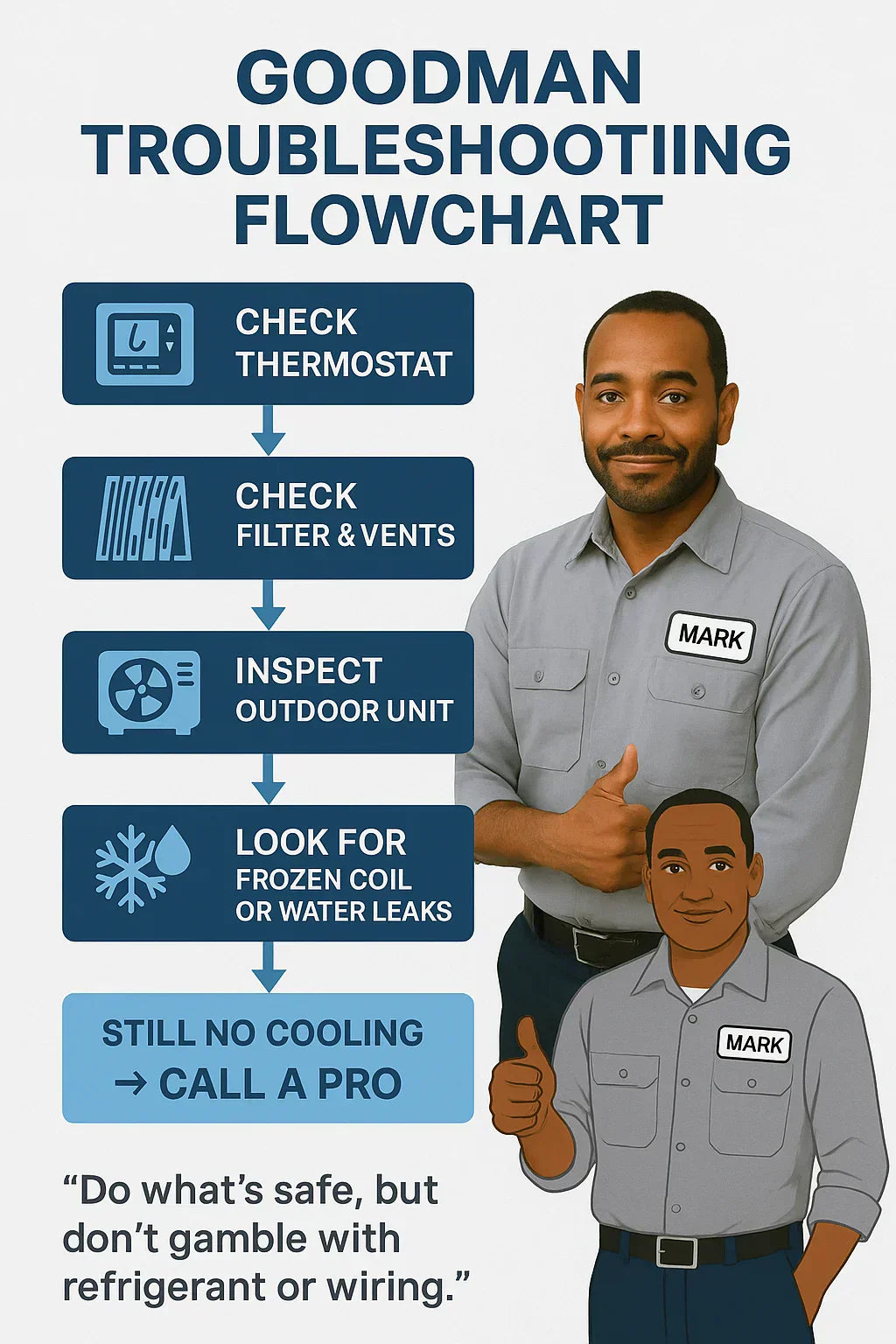Nothing’s worse than cranking on your AC during a sweltering July afternoon and realizing the house isn’t cooling down. I’ve been there with homeowners countless times—standing in front of a Goodman 2.5 Ton 13.8 SEER2 unit that should be running smoothly but isn’t.
The good news? Not every cooling issue requires an expensive repair. Some problems are simple enough for homeowners to diagnose—or even fix—without tools. Others require calling in a licensed HVAC tech.
In this guide, I’ll walk you step by step through the checks I recommend when your Goodman 2.5 Ton system (GLXS3BN3010 condenser + AMST30BU1300 air handler) isn’t cooling right.
📝 Step 1: Start with the Basics
Before you assume the worst, always check the simple stuff.
🎛️ Thermostat Settings
-
Make sure the mode is set to COOL.
-
Verify the temperature setting is at least 3–5°F below the current room temp.
-
Check the fan setting: AUTO is best; ON will run constantly without always cooling.
💡 Mark’s Tip: Sometimes the issue is as simple as a thermostat accidentally set to “HEAT” or “FAN ON.”
⚡ Breaker and Power Supply
-
Go to your electrical panel and check the AC breaker.
-
If it’s tripped, reset it once. If it trips again, that’s a red flag (call a pro).
-
Check the outdoor disconnect box (usually mounted near the condenser).
ENERGY STAR explains thermostat and power basics here.
🌬️ Step 2: Airflow Issues
Poor airflow is one of the top reasons a Goodman system fails to cool.
🪣 Dirty Filters
-
Clogged filters restrict airflow, causing frozen coils and poor cooling.
-
Replace filters every 1–3 months.
📦 Blocked Vents
-
Make sure supply and return vents are open and unblocked.
-
Move furniture, rugs, or drapes away from vents.
🛠️ Duct Problems
-
Leaky or collapsed ducts reduce airflow.
-
Check visible ducts in basements/attics for disconnections or crushed sections.
👉 According to ENERGY STAR, leaky ducts can waste up to 30% of conditioned air.
ENERGY STAR duct efficiency guide.
🏡 Step 3: Outdoor Unit Problems
The outdoor condenser is critical for heat release.
🌿 Blocked Condenser Coil
-
Check for leaves, grass, or debris clogging the coil fins.
-
Clear at least 2 feet of space around the unit.
🌀 Fan Not Running
-
If the condenser fan isn’t spinning, the issue may be:
-
Bad capacitor (common failure).
-
Faulty fan motor.
-
Electrical problem.
-
⚠️ Don’t stick your hand in the fan blades. If the motor hums but won’t start, call a pro.
🏗️ Clearance Problems
-
Units too close to walls or shrubs can’t “breathe.”
-
Goodman recommends 12–18 inches clearance on sides and 5 feet above.
Consumer Reports covers outdoor unit placement.
🛋️ Step 4: Indoor Unit Problems
The air handler is the “engine” of indoor cooling.
❄️ Frozen Evaporator Coil
-
Signs: little to no airflow, ice on refrigerant lines, warm air blowing.
-
Causes: dirty filters, airflow restriction, or low refrigerant.
-
Fix: Turn system OFF, switch fan ON to thaw coil, then replace filters or call a pro.
💧 Clogged Condensate Drain
-
Look for water pooling near the air handler.
-
Clogged drains trigger float switches that shut off cooling.
-
Flush line with vinegar/water solution to clear algae buildup.
⚡ Blower Issues
-
If you hear the system running but no air blows, blower motor may have failed.
Energy.gov on AC coil maintenance.
🧪 Step 5: Refrigerant & Mechanical Issues (Pro Territory)
These aren’t safe for DIYers—call a licensed HVAC technician.
🧊 Low Refrigerant or Leaks
-
Symptoms: weak cooling, hissing sound, frozen coils.
-
Cause: leaks in the copper line set or evaporator coil.
-
Fix: Tech will locate leak, repair, and recharge system.
⚙️ Compressor Problems
-
If the outdoor unit hums but doesn’t start, the compressor may be stuck.
-
Replacement can cost $1,200–$2,000.
🔌 Electrical Failures
-
Bad capacitors, relays, or contactors are common.
-
These require tools and electrical knowledge.
EPA refrigerant safety guidelines.
🚨 Step 6: Red Flags That Require Immediate Service
Don’t wait—shut the system down and call a pro if you notice:
-
Hissing/bubbling sounds: Possible refrigerant leak.
-
Burning smell: Electrical issue.
-
Repeated breaker trips: Serious electrical or compressor problem.
-
System won’t start at all: Could be compressor or control board failure.
👉 My rule: If it involves refrigerant or high voltage beyond a breaker reset, call a professional.
🧰 Mark’s Troubleshooting Flow (Homeowner-Friendly)
Here’s the order I walk homeowners through:
-
Thermostat → Cooling mode, set temp, fan on AUTO.
-
Power → Breaker & disconnect.
-
Filter → Replace if dirty.
-
Vents → Open and clear.
-
Outdoor unit → Clear debris, listen for fan/compressor.
-
Indoor unit → Check for frozen coil or clogged drain.
-
Still no cooling? → Call a licensed HVAC pro.
📊 Real-World Repair Costs (Northeast 2025 Averages)
-
Filter replacement: $20–$30
-
Drain line flush: $100–$200
-
Capacitor replacement: $150–$300
-
Refrigerant leak repair + recharge: $500–$1,200
-
Compressor replacement: $1,200–$2,000
-
Full system replacement: $5,000–$6,500
✅ Bottom Line: Don’t Panic, Troubleshoot Smart
Your Goodman 2.5 Ton 13.8 SEER2 system is a solid unit—but no AC is immune to problems.
-
Start with simple homeowner checks (thermostat, filters, vents, breakers).
-
Move to basic visual inspections (outdoor debris, frozen coil, clogged drain).
-
Leave refrigerant and electrical work to the pros.
👉 My advice: “Do what’s safe, but don’t gamble with refrigerant or wiring. When in doubt, shut it down and call a pro.”
In the next topic we will know more about: Clearance & Fit: Will a 2.5 Ton Goodman System Work in Your Utility Space?







